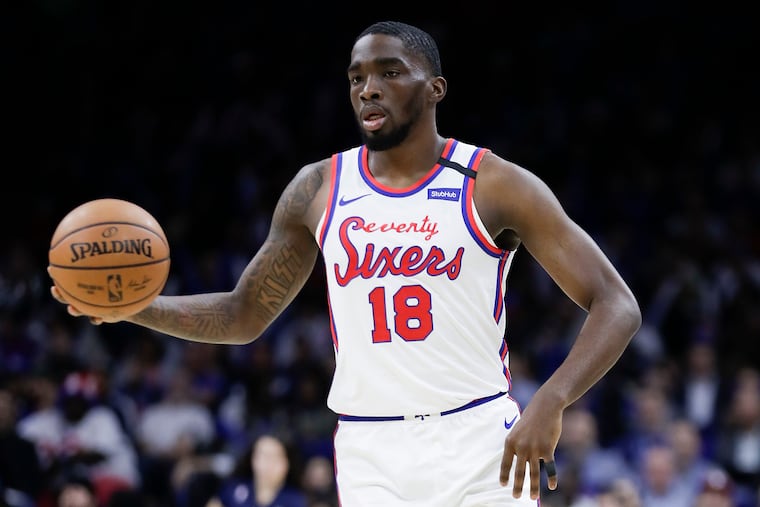Put the Sixers in the NBA’s COVID-19 bubble, and Shake Milton becomes an intriguing and important player | Mike Sielski
The Sixers have only so many options to improve their offense once their season resumes. Starting Milton at point guard is the best one.

People forget this, if they even knew it at all, but the 76ers committed to Shake Milton before they committed to Ben Simmons. That’s a loaded statement, of course, but technically, it’s the truth. A year ago Thursday, the Sixers confirmed that they had signed Milton to a three-year contract, with a team option for a fourth year, for a total of less than $7 million. Then, on July 15, they reached an agreement with Simmons on a five-year max extension for reportedly $170 million.
Those dollar figures represented the obvious reality at the time. The Sixers regarded Simmons as one of their cornerstones and Milton as a promising young piece in whom they were willing to invest, at a modest cost, in the hope he would develop into a member of their regular rotation. But that time is gone, and it wasn’t just the coronavirus that erased it.
Think back, all those decades ago, to late February. Simmons had injured his back in a lopsided, embarrassing Sixers loss to the Bucks in Milwaukee. Milton replaced him as the team’s de facto starting point guard, and over those next nine games, he was a marvel: averaging 17.8 points, shooting better than 60% from three-point range, making 13 straight threes, scoring 39 points in a jaw-dropping performance against the Clippers.
If over time Milton was capable of maintaining or even approaching that measure of production, it would open up all kinds of possibilities for the Sixers once Simmons healed and returned to the lineup.
“If you would have told me he would make 13 straight threes and score 39 against the Clippers, I might not have believed it,” former Sixers coach Larry Brown, who coached Milton at SMU, told The Inquirer in early March. “But I really believed he was an NBA player. He is an unbelievably hard worker, and he has an unbelievably high I.Q.”
So here we are, with nearly four months having passed since the Sixers last played. Simmons is “good to go,” according to coach Brett Brown. The NBA season is scheduled to resume, inside the Orlando bubble, on July 31. And someone asked Brown during a Zoom call Wednesday what his plan was when it came to the point guard who would back up Simmons.
“You’d have to say that Shake put his hand up in a very definitive way initially,” Brown said. “Does it play out like that after a few weeks in Orlando and a camp? I don’t know. I say this all the time, like if we were back at the start of camp: The gym’s going to speak. By and large, everybody walks out of gyms in unison, [saying], ‘He’s clearly won the spot.’
“I do feel if you go back to my wish, growing Ben in multiple areas, at times you’ll see [Jason Richardson] with the ball. You may see Shake with the ball in a funny situation. You may see [Furkan Korkmaz] bring it up or Alec Burks bring it up. I don’t feel entirely locked in to ‘Here is the backup point guard’ because of the variety of the team we have and the versatility that we can play with. I feel very strongly about that.”
There’s an even better reason that Brown shouldn’t feel locked in to have Milton back up Simmons: He should feel locked in to starting Milton alongside Simmons. He might already be inching his way toward that conclusion. Brown spoke Wednesday of a lineup deployment featuring “Team Joel” and “Team Al,” a reference to Joel Embiid and Al Horford and an acknowledgement that the all-in experiment of pairing the two big men had, to put it mildly, not worked. “Our offense at times has been a little clunky,” Brown said.
What would streamline it? Everyone already knows the answers. More perimeter scoring. Better floor spacing. Bringing Horford off the bench to spell Embiid and anchor the second unit. The Sixers have only so many ways to make those necessary changes. They could entertain the pie-in-the-sky notion that Simmons used his time away to become a better and less-reluctant outside shooter. Unlikely. Or, they could do what they have done whenever Embiid has been sidelined: take the ball out of Simmons’ hands, play him at the power-forward spot, and make Milton the starting point guard.
If it’s versatility that Brown wants, a lineup of Embiid (7-foot-2), Simmons (6-10), Tobias Harris (6-8), Richardson (6-6), and Milton (6-5) could provide it. With Simmons on the floor, the Sixers can still push the ball whenever such opportunities present themselves. But with Milton orchestrating the offense and Simmons closer to the rim, they can run more fluid halfcourt sets because teams would no longer have the luxury of laying off Simmons and daring him to take an 18-to-20 foot jumper. Opponents would have to honor Milton’s ability to make long-distance shots, and presumably, everything else would open up for the Sixers: easier passes to Embiid in the post, better looks for Harris, better uses of Simmons’ speed and strength and vision.
That might seem a lot to lay on Milton, 23, a late second-round draft pick in 2018 whom the Sixers acquired in a trade with the Dallas Mavericks. He has just 52 games of NBA experience, and lots of guys can have a great nine-game stretch. But Brown doesn’t have all that many options here, and relying more on Milton seems his best one. Out of that $177 million the Sixers invested a year ago, it would be something if the first $7 million turned out to be the smarter money.